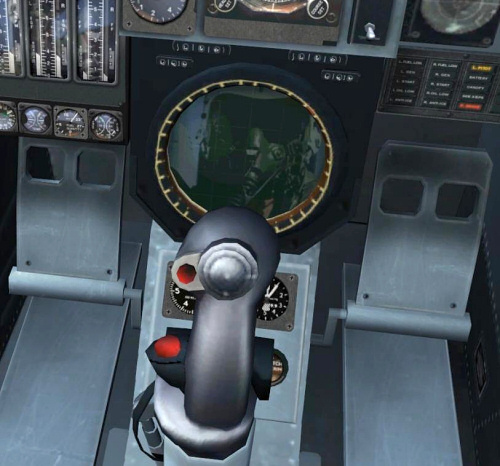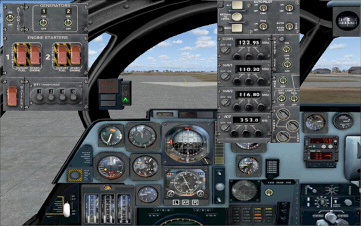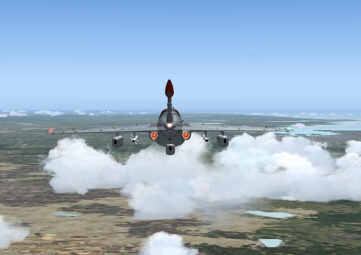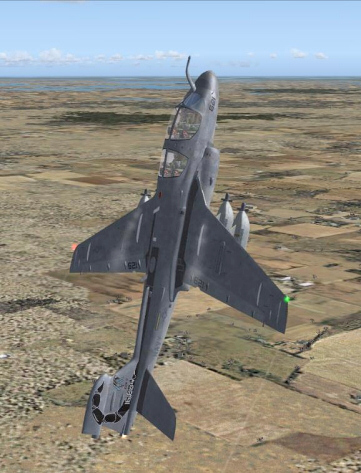|
December 2007

Introduction
From the AlphaSim Reference Notes: The Grumman EA-6B
is a modification of the basic A-6 airframe into a
long-range, all-weather, advanced electronic
countermeasures platform. It is the U.S. Navy and Marine
Corps primary electronic warfare platform and has seen
action in nearly every conflict since its introduction
in 1971. A total of 170 examples were produced and the
aircraft is still in active service.
In my Navy days, I saw many of the predecessors of
this aircraft, the basic Grumman A-6 Intruder. Seeing
this airframe brings back some memories for me of a time
when I had no grey in my hair and more
fire in my belly. The Intruder has morphed into
something else entirely too, the Prowler. The Intruders
are gone, retired from active service in the late 90s.
The Prowlers remain.
They were a marvel when introduced. I recall that aviation
technology at that time, even as practiced by the
military, was considerably more primitive that what we
now enjoy. There was no GPS system.
Microprocessors were just beginning to come into use.
Glass cockpits, Cat III approaches, autoland, RNAV, FMCs,
TCAS and a whole host of high-tech tools the modern
pilot might have at his disposal were just a gleam in
the eye of far-seeing designers. It is easy to lose
sight of the fact that these now-dated aircraft, both
the Prowler and its older, slightly smaller but very
similar looking brother, were very high-tech for their
time. They both brought new capabilities, largely
contained within high-tech black boxes, to the combat
flight environment. That made both aircraft truly
revolutionary in their individual roles. Each could do
things none of their predecessors could.
The Prowler was developed from the Intruder airframe to
meet a requirement that was born of an ongoing war in
Vietnam. An urgent need was recognized for a dedicated
electronic warfare platform able to operate from the
carriers. The aircraft that fulfilled that requirement
would need performance comparable to that of the other
aircraft for whom it would run electronic interference,
the Intruders, Skyhawks (Öthink A-4, not C-172),
Phantoms, Corsair IIs and Crusaders. It needed the same
all-weather capability. It also needed the ability to
cloak its companions from the all-seeing eye of the
Russian and Chinese air defence systems that were
pervasive.
Using the basic A-6 Intruder airframe, already in
production and proven, Grumman changed it remarkably
little. The strong airframe, great load-carrying
capability and high performance that the Intruder
already possessed were employed to great advantage to
make its spun-off cousin as good at its job as the
Intruder was in the attack role.
Down to
business
The Prowler, the EA-6B is the bird Grumman produced and
thatís the bird AlphaSim has provided us with in this
excellent add-on. AlphaSim has done a commendable job
with it.
The external model is excellent. Four model variations
are provided, all the same basic airframe but with
different under-wing stores attached and different paint
jobs, two Marine and four Navy. Navy and Marine Corps
squadron paint schemes can be quite colourful and these
six donít disappoint. They are interesting and appear to
be accurately done. Under-wing and centre-point stores
consist of various mixes of AN/ALQ-99 jamming pods, fuel
tanks and AGM-88 HARM missiles. Youíre
going to love the eye candy.
 |
|
4 models / 6
paint schemes |
The aircraft is available by download only as is
standard with all AlphaSim products. Installation was
quick and easy with no surprises or difficult spots.
Now lets jump into the cockpit with three of our closest
friends and fly it. Cockpit visibility is very good,
both on the ground and in the air. Thereís a nice touch
with canopy reflections; they donít interfere with the
view, but if you pan or view something thatís moving
relative to the aircraft, itís very obvious that thereís
a layer of transparent material between you and the
outside world. Itís a very subtly done effect that you
donít notice until there is motion; itís incredibly
realistic. There are also reflections on some of the
instrument faces. Most notably, if you go to the VC and
pan down to the radar scope near the bottom of the
panel, thereís a large reflection of a handsome devil in
helmet and oxygen mask staring back at you.
 |
|
Handsome Devil! |
The panels are nicely done in both the 2D and 3D mode.
There are roll-over Tool Tip tags available on most of
the instruments and controls, though not all. Four
standard FS pop-up buttons bring up the native FS ATC,
Map, GPS and Kneeboard. There are three additional
non-FS style buttons on the panel that bring up radios,
autopilot and some engine and electrical functions.
There are two very good files included that come up on
the Kneeboardís Reference and Checklist pages, much
better than are normally seen. Of course the standard
ATC, Flight Plan and FS Key Assignment pages are also on
the Kneeboard. In the FSX version the radar in the 2D
panel is usable in a popup.
CLICK ON
PICTURE FOR FULL SIZE VIEW
 |
 |
|
2D Panel |
Sub-Panels |
The panel includes a radar altimeter, but I could find
no way to set the DH alert. Of course the obligatory AoA
Indexer (Angle of Attack) is present on the left canopy
frame, as it is on any carrier-capable USN aircraft.
Integrated with the AoA display are a pair of very handy
illuminated switches for the speed-brakes and tail-hook
as well as a big, red landing gear warning light. It
would be hard to miss that one. Nearby, on the top-left
edge of the panel is an AoA gauge. This little corner of
the world becomes an area of intense focus for intrepid
Naval Aviators when motoring down the glide slope to the
boat.
The vertically oriented tape style engine instruments
are present in three pairs on the lower left of the
panel but are poorly labeled in both views and these
particular instruments have no Tool Tips to help out.
The 3D panel provides four additional engine gauges
below the tapes. There is no fuel quantity instrument
visible in the 2D panel, though one is available on the
3D view. There is a very nice red LED dual DME readout
and NAV radio control that displays the frequency and
the three-letter identifier of the station tuned. It
remains visible when the radio stack is hidden. It can
be switched between NAVI and NAV2 and also displays the
DME readout for both NAV sets simultaneously. Itís the
best thing of its type that Iíve ever encountered. If
this is typical, Iím going to have to fly jets more
often.
 |
The centre console sports a number of switches, buttons,
knobs and the like. A number of them operate, many do
not. Of those that operate, most have Tool Tip labels;
some do not. The function of the latter are a mystery
and they may well have no function at all Ė just
ambiance. The left hand side console also has an array
of switches but none respond to the mouse. There are
working power levers and a flap lever on that side Ė
nothing else there is functional. The cockpit looks
good. Panning around in 3D view you really get the feel
youíre in the aircraft. It looks like it ought to. One
possible deficiency is the lack of any portion of the
left wing visible in the 45 degree left rear view. It
looks like part of the wing ought to be visible in that
view, but itís not. Itís a small point. |
|
DME Gauge |
|
A nice feature included on the kneeboard reference list
is a table of weights for the various under-wing stores.
The aircraft has dedicated loading stations for each of
the four crew (you can simulate your mother-in-law in
the right rear by setting it to 400 lbs), 200 lbs of
survival gear, drop tanks and various hard-points for
HARM missiles and jamming pods, five in all. There is
nothing to prevent you configuring the aircraft weight
accurately for any of the provided combinations of
under-wing hardware and all the information needed to do
so is on the kneeboard, a nice touch.
Ground handling is easy and precise. Unlike some AC,
full rudder without differential braking results in a
reasonably short radius turn, no doubt just the thing on
a crowded carrier deck. The throttle lag typical of
turbojets is quite pronounced and feels realistic.
Taxiing at a smooth, constant speed is a bit like
driving on ice in that you must have an ďanticipation
horizonĒ a little further out ahead than you may be
accustomed to if you normally fly piston engines.
Engine and cockpit sounds are quite good, the engine
sounds particularly so at higher power settings. Cockpit
noise persists after a total shutdown, even after
opening the avionics and battery switches. One assumes
it must be a ground power unit operating nearby.
Unexpectedly, this aircraft is a hot rod! Well, yes,
itís sub-sonic, the engines are non-afterburning and
itís a 50,000 lb plus AC with a thrust to weight ratio
less than 1, but itís not an under-powered slouch. Itís
powerful, fast and slippery. To me it flies like a heavy
biz-jet Ė on steroids. In my first long flight I climbed
from near sea level to 15,000 feet at 230 knots with the
VSI pegged at 6,000 + ft/min. the whole short time.
Thatís as high as I was going, but I didnít have any
sense that I was running out of steam. Keeping the
Prowler below the 250 KIAS ATC speed limit in level
flight below 10,000 feet takes some concentration. The
throttles have to come far back to avoid speed
excursions above the 250 knot limit.
Handling in the air is crisp and responsive. The roll
rate is excellent (see description below of the
ailerons). Lateral stability is quite good. Longitudinal
stability is another matter. Pitch requires careful
attentionÖor the autopilot. Maintaining an altitude
manually is possible, but requires painstaking
concentration. I suspect it is so in the real AC as
well.
Takeoff is a rush. The Prowler accelerates quite well,
particularly if you hold it with the brakes until the
engines spool up. It requires a relatively high speed to
lift off. Rotation at 130 knots is standard and I have
not seen the AC lift off below about 140 knots. This
requires a fair amount of runway if heavy, but once the
wheels are in the wells and the flaps up, performance is
very, very good for an aircraft in this weight class.
Care is needed to see that the pitch trim is set neutral
for takeoff. Thereís a gauge, but itís only in the VC
cockpit and only viewable by moving the stick to one
side. I had to look for a long time before finding it.
Check it before you start rolling, you wonít be able to
manage it on the fly.
A moderately effective speed brake is provided,
consisting of a pair of short spoilers on the trailing
edge of the wings at the tips. They deploy by splitting,
one half deflecting upward and the other downward,
producing a front-on view that is uniquely
Prowler/Intruder. Because they are split, the speed
brakes donít seem to cause any pitch change. Opening and
closing them as needed is quick and simple and the only
reaction from the AC is the one you want, speed. Of
course if you leave them open and slow too much youíll
sink or will have to pitch up to remain level, but
thatís just Wilbur and Orville 101.
CLICK ON
PICTURE FOR FULL SIZE VIEW
 |
|
Distinctive Speed-Brake Configuration |
The ailerons and flaps are...odd. They are really two
parts of a single wing section, unlike the more normal
configuration where the ailerons lie outboard of the
flaps. The entire trailing edge is involved in AC
control. At the outer tips are the speed-brake panels,
but they are short, not extending far inward from the
tips. Everything inboard of the speed-brakes to the wing
root is both flap and aileron. The lower part, of
course, is the flap. Above and just forward is a
spoiler-like control surface that deflects upward for
roll control Ė there is no corresponding downward
deflection on the opposite side. Since the surface is so
long, extending all the way from the root out to the
short speed-brake section near the tip, it is quite
effective. There are only two flap settings Ė I came to
think of them as ďalmost allĒ and ďallĒ. Leading edge
slats deploy in conjunction with the flaps, a pretty
neat effect in the external view. I assume the odd
aileron configuration accurately reflects the real
aircraft.
CLICK ON
PICTURE FOR FULL SIZE VIEW
 |
 |
|
Flaps, Slats, Speed-Brakes, Right Aileron |
Sexy Exhaust Flames |
In flight there are good contrail ribbon effects off the
open speed brakes at the wing tips and a well-rendered,
smoky jet exhaust effect. An external view shows fire in
the exhausts at higher power settings, looking a lot
like afterburner manifold-rings, but this AC doesnít
have afterburners. The effect is only visible within the
exhaust nozzles Ė thereís no external tongue of flame or
shock cone. I donít think that effect is accurate, but
to be honest Iím not sure. It is sexy though!
 |
|
Tip Contrails and Condensation Effect Near
Wing Roots |
This is a very well done add-on. I find the external
models very satisfying. The 2D and 3D cockpits are
functional for either drilling holes in the sky or a
serious IFR flight. The latter attribute is sometimes
poorly implemented in add-on military AC, which the
publishers seem to think are only ever flown in
severe-clear ACM. My testing was all in FS9 and even
with all the sliders all the way up, performance never
faltered.
Animations include front and rear canopies and the
associated folding steps, the tail-hook, wing fold,
speed-brakes and of course the usual landing gear,
flaps, slats and other flight control surfaces. There is
a key for toggling the aircrew AWOL or
all-present-and-accounted-for. All those animations are
well done.
|
 |
|
AWOL crew and
most external animations shown |
There is a reference page htm file and the checklist file
along with a brief read-me that provides some much-needed
information, but there is no manual provided and
thereís more information needed. A 2D and 3D cockpit
diagram and some explanation of how certain things (e.g. AoA indexer, DME gauge) function would be
most welcome.
CLICK ON
PICTURE FOR FULL SIZE VIEW
|
It is worth mentioning here the full FSX version
takes this aircraft into another dimension.
The
guys at AlphaSim certainly know how to make the
best from the SP2 SDK, the FSX version gets the
added bonus of bump mapping, self shadowing
externals, VC
Self shadowing (requires FSX, SP2 and Vista) a working
radar popup in 2D mode and 2 rear cockpit views.
(This final feature not modelled in the FS9
version).
If you don't have FSX It's worth
upgrading just to get these features!
|
 |
| |
Rear VC view in
the FSX model |
In summary, this is a very well programmed package. The
external model, flight model and performance is very, very good. Itís a lot
of fun to fly!
John Allard
|